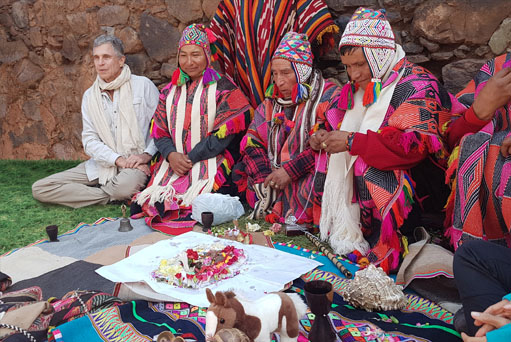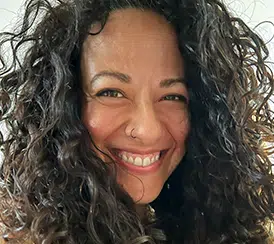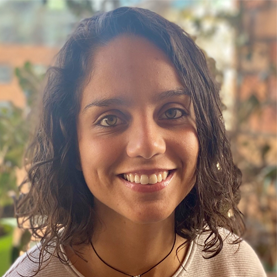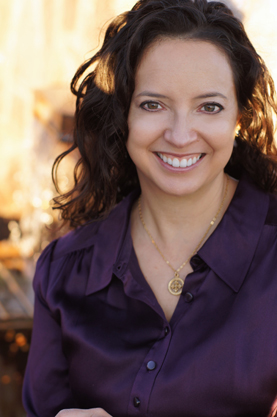
Traditionally, in the Andes, a despacho ceremony is performed (individually or communally) after each earth cycle to renew and re-imprint the powers of nature on our luminous body, to connect with the Universe and accomplish perfect ayni – not for us personally, but for the wellbeing of our “Ayllu” or group. A despacho brings the shaman into harmonious relationship with Heaven and Earth, aligning the three worlds of the Uhupacha, Kaypacha, Hanqpacha and the archetypical organizing principles of the Universe. Each item of offering represents a prayer and a gift of power that sparks the momentum for energy shifts and healing.
The steps to create your own despacho are simple:
Begin with a large piece of white or colored paper. This will be the “wrapping” for your offering – think of it as a present. Flip chart paper or non-foil wrapping paper works well.
Fold the paper into thirds one way and then thirds the other way so you have nine squares.
Working within the center square, you begin to layer the burnable objects that have been informed with your breath, so the energetic essence of your prayers is within each one.
A suggested list of contents, order and their meaning is below; however, there really are no rules. Create your prayer bundle in a way that is meaningful to you. Once you have filled the despacho with your prayers and vision for yourself and the Earth, fold the bundle into the shape of a gift; left to right, right to left; then bottom up and top down. Tie it with a white cord and add one “Qintu” (an organized stack fashioned with three leaves from a native tree, informed with a prayer) tucked into the yarn for any “forgotten prayers.”
Ingredient suggestions and their representations:
- Large piece of white paper: Envelope of dreams in which we “write” our prayers. Blow your intent for reciprocity and balance in to this empty, folded gift.
- Sugar: Represents sweetness and love.
- Qintu: In Peru, they typically use three coca leaves, but you can utilize three small leaves from trees native to your area. We often use bay leaves, so look for leaves about that size.
- Red and White Carnations: Red for the Earth and white for the mountains. Place a red and a white carnation petal on top of the Qintu (to represent the snow-covered mountains reaching the Heavens) on top of the red petal representing the Earth.
- Build the foundation of the despacho with the Quintus, informing each with your prayer (use a minimum of 12 Qintus).
- Cover the Qintus with a little more sugar, representing even more love and sweetness.
- Place one open shell in the middle of the prayers, representing the womb of the Earth, our source and birthplace. This holds us, nourishes us, and provides opportunity and safety.
.
Now feed your prayers with a handful of what sustains you:
- Rice: Fertility and abundance, to bring your prayers into fruition.
- Various grains: Sustenance.
- Nuts: Gifts for the Plant People.
- Beans: For protection, abundance, power places, and the springs that nourish us.
- Corn: Sustenance, gift back to the Earth for what we have been given.
- Raisins: Spirits of our ancestors, our blood lineage.
- Figs: Spirits of the ancient ones who dwell in the sacred mountains.
- Alphabet noodles: To step outside and beyond language.
- Animal crackers for animal spirits, and health.
.
And then add a few more pinches of “sweetness”:
- Candies, candy hearts, sweet gum drops, candy corn, etc.: Represent everything we are in relationship with.
- Chocolate: Pachamama LOVES chocolate.
- Loose sage or other incense: To feed the elements of the Earth.
- Black licorice for protection.
- Gummy or candy frogs: Represent messengers, envoys to carry our prayers; and cycle of waters.
- “Play” money (one piece): To ensure successfulness of the despacho.
- Unraveled cotton balls (clouds): Represent aware-time and dream-time.
- Confetti stars: Represent connection to the stars.
- Colored confetti or sprinkles: To celebrate all life.
- Rainbow yarn: Represents the bridge between the worlds.
- Red and white ribbons: to honor our path as humans with a physical body (red like blood) and spiritual nature (white). Together they are the ‘hatun ñan’(the great road).
- Flower petals for healing.
.
When you have placed all your items in the despacho, the corners of the large paper are then folded over the contents so that they all overlap at the center to form a smaller square. Tie the despacho without flipping it over so that all the prayers are sustained.
The despacho can be either buried (for slow, steady results), burned (for quicker transformation), or fed to the running waters ceremonially within a reasonable amount of time after it is prepared. When the despacho is placed into the fire, participants generally do not look towards the flames until after the offering has been burnt. This symbolizes non-attachment to the outcome and release of all claim to that which has been given away.
.







